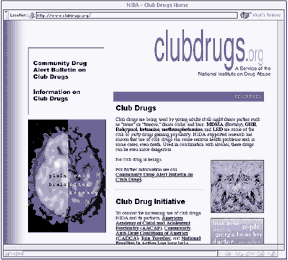|
Responding to the alarming recent rise in use of club drugs, NIDA has initiated a broad-based public initiative to inform and educate teens, young adults, parents, and communities about the dangers of drugs such as "ecstasy," "roofies," and GHB.
"Young adults believe club drugs can harmlessly enhance their experience at dance parties and 'raves,' but there is no safe way to use any of these drugs," said NIDA Director Dr. Alan I. Leshner. "Research shows that some of the so-called club drugs have long-lasting effects on the brain. Combined with alcohol, these drugs are even more dangerous, sometimes deadly. There is no such thing as a harmless club drug. There is no such thing as recreational drug use."
At a Washington, D.C., press conference, Dr. Leshner announced that NIDA was teaming up with the American Academy of Child and Adolescent Psychiatry, the Community Anti-Drug Coalitions of America, Join Together, and National Families in Action to increase public awareness of the effects of club drugs. As part of the initiative, Dr. Leshner said, NIDA is increasing its funding for club drug research by 40 percent, to $54 million. In addition, NIDA has developed a multimedia campaign, including a new Web site - www.clubdrugs.org - to disseminate science-based information about the drugs.
"Accurate, credible information is the most powerful weapon we have to combat the increasing use of these dangerous drugs," said NIDA Associate Director Dr. Timothy P. Condon. "Our Web site will provide up-to-date information 24 hours a day. We are distributing 250,000 copies of a special Community Drug Alert Bulletin that explains where these drugs are being used and what science has revealed about the way they work. And we are placing more than 330,000 free colorful 'HotStamp' cards-which show how using ecstasy can disrupt brain function-in restaurants, bars, coffee shops, and bookstores."
NIDA's initiative represents an important first step in reducing club drug use, said Dr. David Rosenbloom, director of Join Together, a project organized by the Boston University School of Public Health to serve as a national resource for information that community-level organizations can use to prevent drug use. "This is NIDA's early warning alarm. It sends a very clear signal to the Nation," Dr. Rosenbloom said. "We need to act quickly, distribute accurate scientific information, and reverse the pattern of increasing use of these dangerous drugs."
 This new Web site - www.clubdrugs.org - provides information on club drugs and their effects. |
|